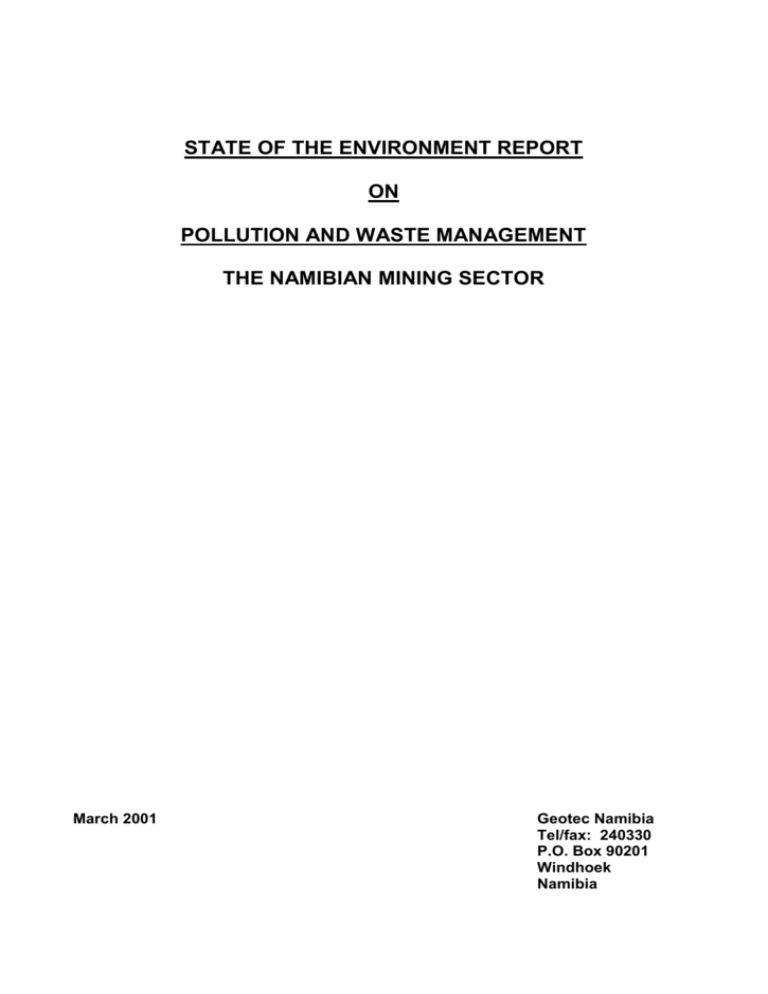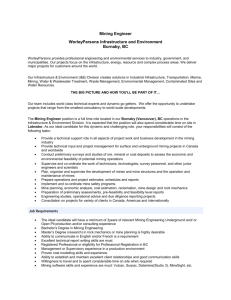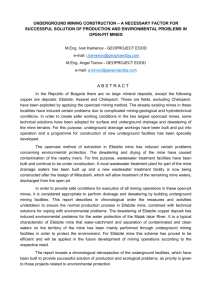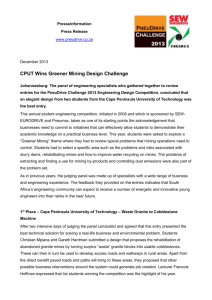E-Mining
advertisement

STATE OF THE ENVIRONMENT REPORT ON POLLUTION AND WASTE MANAGEMENT THE NAMIBIAN MINING SECTOR March 2001 Geotec Namibia Tel/fax: 240330 P.O. Box 90201 Windhoek Namibia Table of Contents 1. Introduction 2. Project Objectives 3. Project Methodology 4. Summary and Conclusions 5. Analysis and Recommendations References Glossary of terms Appendix A - Classification of Mines Appendix B - Toscani Diamond Appendix C - Ugab Salt Appendix D - Nolidas Quarry Appendix E - Rössing Quarry Appendix F - Rössing Mine Appendix G - Navachab Mine Appendix H - Palisandro Quarry Appendix I - White Rhino Quarry Appendix J - Rubicon Mine Appendix K - Krantzberg Appendix L - Uis Mine Appendix M - Brandberg West Appendix N - Otjizonjati Mine Appendix O - Otjisondu Appendix P - Tsumeb / Ongopolo 2 State of the Environment Report - Pollution and Waste Management The Namibian Mining Sector 1. Introduction Geotec Namibia were appointed by Namibia Global Research to examine the environmental impacts of the past and present mining and quarrying activities in Namibia. There is a perception that the past mining activities have caused serious environmental damage due to the lack of awareness, poor management and regulatory intervention. The proposed Pollution Control and Waste Management Act is designed to address this situation, and this report provides an overview of the situation and provides indicators to the more significant areas of impact. The Directorate of the Geological Survey of Namibia (GSN) provided a list of over 220 mines that have been abandoned or officially closed. This list has been used for a base line study of the environmental status of old mines whereby a classification system has been drawn up. In addition to this secondary data collection and processing a limited primary data collection has been undertaken whereby selected past and present mining and quarrying operations were visited and studied. 2. Project Objectives By combining the requirements of the client as laid out in the T.O.R., the experience of the mining sector consultant and the past and current sectoral programmes, the study has focused on the following objectives:- ` To develop an administrative template covering all significant biogeophysical and socio-economic impacts in order to provide a classification system. To highlight significant negative impacts for inclusion in future regulatory measures and for “best practice” procedures. In order to achieve these objectives, it has been agreed that a representative sample of past and present operations be studied in order to identify these factors. Thus the report is a situation analysis and not a definitive study such as has been carried out by the recent German/Namibian Geological Survey studies and the European Union funded Sysmin study currently underway. 3. Project Methodology In order to maximise outputs from the study, it was agreed that the programme be divided into two sections:a national data base comprising secondary data from GSN and Mines data bases. The collection of primary data from a selection of past and current mines and quarries. 3 2– The secondary data has been collected and incorporated into an expanded table based on the GSN mine list. - The additional data includes: - On site mineral processing the presence or not of tailings the presence or not of waste rock mining methods employed cross referencing with available publications a pollution potential classification This latter classification is based on such critical factors as: climate hydrology hydrogeology topography site geology mineral processing mineralisation The classification system is presented in Appendix A. In addition to the tabular presentation of available statistics, a base map indicating the location of 170 mines has been reproduced for this study at a scale of 1:4000 000 by the GSN. Figure 1. The mines rated as Class A and Class have been highlighted on this map. The primary data sample is indicated on Figure 2 at a scale of 1:1000 000 which covers the central section of the country. Primary data has been collected from the following localities:Toscanini Diamonds Ugab Salt Pans Nolidas Quarry Rössing Quarry Rössing Mine Navachab Mine Palisandro Marble White Rhino Marble Rubicon Mine Krantzberg Mine Uis Mine Brandberg West Mine Otjisanjati Mine Otisondu Mine Tsumeb / Ongopolo Mine 4 -3 – These are currently operational. The active mines / quarries were visited together with the environmental officer or a responsible staff member. In all cases a friendly constructive attitude was found. The primary data was derived from existing reports and site inspections. As required by the primary consultants this data and observations has been presented in tabulated form in Appendices Bto P. This base line data has been recorded under primary headings such as physical, geological, biophysical environment and available mining factors. From this data and observations the significant environmental impacts can be highlighted. These include waste volumes, hydrology groundwater and social issues. In each case an impact evaluation or summary has been drawn up. The mines and quarries reviewed in the study were selected on the basis of differing geological, mining and climatic setting, on the size and complexity of the mining operation and current status of the mine. At the request of the client the Rössing Uranium Mine and the Ongopolo Mine/Smelter were added to the original list. In the case of major mines ortho photo plans have been produced by the scanning and enlarging of existing high-flown, recent aerial photography. These are: Brandberg West Uis Mine Navachab Rössing Mine Tsumeb On these ortho photo plans potential pollution areas have been indicated. Field observations on these areas are covered in the tabulated site reports. For the smaller operations the mine / quarry is indicated on 1:250 000 map sheets. A site report for each operation has also been compiled. Each mine / Quarry visited has a separate Appendices. Bto P. The Rehabilitation of Abandoned Mines reports from studies carried out by the German Geological Survey (BGR) and the GSN have been completed and the documents arrived in Namibia at the end of April 2001. This study covered the following mines: Klein Aub Matchless Oamites Onguati 5 -4– Khan Namib Lead - in the Phase I Study and the first three in more detail for the Phase II Study. These studies include detailed water, soil and rock sampling, geotechnical appraisals of mine workings and waste dumps to determine remedial measures and costs for addressing pollution problems. The Ongopolo Trust is currently funding a detailed audit of the environmental situation at the old Tsumeb Mine and the Ongopolo smelter. The primary and secondary data has been summarised in section 4 of this report in order to define the most significant impacts of the mining sector. The opportunity is made to briefly discuss their interaction with the biogeophysical environment prior to presenting recommendation for monitoring regulation and decommissioning in section 5. 4. Summary and Conclusions In developing a pollution potential classification for mines and quarries it is important that the indicators are consistent for all types of facilities and for past, present and future operations. This is why aspects of mineral processing and waste disposal have been added to the original table of mines generated by GSN. (Appendix A) The most important indicators used in deriving a working classification are: Site geology Mineralisation Hydrogeology Hydrology/topography Climatic regime Biological environment Other factors include: Process and operation issues Socio-cultural background Socio-economic situation Aesethetics In most cases these are interactive and this holistic approach has been the basis of the classification presented in Appendix A. The mines designated Class A are those that due to a combination of mineralogy, host rock geology, ground and surface water and ore processing produce sulphurous/acid waste or other noxious materials. 6 -5The A class has been sub-divided into closed mines where these situations are observed and operating mines where this is a potential situation, but currently under control. The latter include Rössing, Ongopolo and Rosh Pinah. The Class A closed mines are:* * * * * Oamites Kopermyn Klein Aub Tsumeb Mine Hope-Gorob Matchless Namib Lead Abenab West Berg Aukas Uis Abenab Golden Valley 70 45 - 56 in reference 1 36 “ 43 “ 22 “ “ 26 “ “ 52 “ 29 “ 95 “ 51 “ 89 “ The Class B mines/quarries are those that pose environmental threats through dust pollution, unprotected excavation and unstable rock or waste dumps. Of the current mines only Ongopolo has this situation but has been classified as an A facility due to its chemical pollution potential. B Class mines include: * * * * * Khan Mine Alt Bobos Gross Otavi Guchas Ondundu Brandberg West Onguati Elbe Klein Aukas Auchas Humdigams Pauknab Sandamap Ameib Krantzberg Aukam Rubikon Karlowa Helokon Lorelei Seven Pillar Neuhof Okaruiput Plattfeld Dan Mines 110 - 57 in reference 1 “ 30 “ “ 87 “ 96 “ 37 “ 75 “ 47 “ “ 102 “ 105 “ 109 “ “ 112 “ 104 “ 180 “ 98 “ 121 “ 18 “ 19 “ 7 -6Ysterputz Troye Aukam Kanbium Petalite Orawab White Ridge Amis Valley Mon Repos Usakos West Trekkopje Karibib Town Quarry Alsato Bobos Lime Hoba Lime 135 “ 114 “ 153 “ Mines visited by the consultant. This classification system has been drawn up by a literature search from discussions with the mines inspectorate in the Ministry of Mines and Energy (MME) and from consultation with private sector specialists. The full list together with Classes C and D is presented in Appendix A. 5. Analysis and Recommendations Since the late 19th century mining has played an important role in the national economy. Evidence suggests that even before colonial times, the exploitation of copper was widespread. In the period 1983 – 1990 mining contributed an average of 23% of the GDP. This dropped to 12% during the period up to 1998. However, minerals contributed 44% of export earning and around 10% of Government tax revenue. In addition, the sector has made significant contribution in the fields of education and social development programmes – Concordia College, Rössing Foundation and the Namibian Institute for Mining and Technology. These factors represent the positive social and economic impacts of the mining sector, and it is important that it continues to do so. The negative aspects of the mining sector activities has been reviewed by this and the BGR/GSN studies resulting in an inventory of mining/quarrying operations and an environmental impact classification. This situation has been brought about by the lack of environmental regulations, and the non-requirement of mining companies to provide guarantees and decommissioning programmes for restoration and closure. In reviewing the “State of the Environment” with reference to the mining sector, it has been stressed in the previous section – Summary and Conclusions – that the indicators used for past, present and future assessments and audits should be consistent and holistic. 8 -75.1 Abandoned Mines The interventions will vary for the 3 categories since it may not be feasible or affordable to rehabilitate all abandoned operations. Since 1992 when the Minerals (Prospecting and Mining) Act was promulgated, operators wishing to close a mining or quarry have been required to remove all buildings, close adits and shafts, fence excavations etc. to the satisfaction of the MME. They have also been allowed tax deduction for such decommissioning. However, this has not been carried out in the cases of Namib Lead, Rubicon and Helikon Mines. Many other abandonments precede this Act. Consequently abandoned mines falling into Classes A and B continue as a liability to the nation. It remains to be seen what the proposed Pollution Control and Waste Management Act can initiate as rehabilitation programmes. Interventions required will include: monitoring systems for air and water pollution excavation stability analysis stability assessments of rock and tailing dumps solid waste auditing aesethics social impact assessment of abandoned communities restoration programmes costs From the data presented in Appendix A, twelve mines are Class A with serious pollution potential and 40 are Class B. It is important that at least the Class A mines are examined in more detail together with the water quality section of the Directorate of Water Affairs (DEA) who are responsible for pollution control matters. 5.2 Existing Mines and Quarries The larger mines are generally associated with international and global mining groups and operate inhouse auditing and closure planning or compliance with internationally recognised certification such as ISO 14001. Consequently whilst these mines have a Class A pollution potential, the situation is managed and monitored through existing legislation, DEA licencing and international best practice. Monitoring and auditing procedures include: dust emissions noise emissions medical checks on staff ground and surface water monitoring waste rock and tailings stability solid waste management waste water processing 9 -8water management programmes Ongoing closure planning is undertaken for final mine decommissioning. Inputs include: review and audits of closure options closure activity plans impacts on personnel, resources labour release programmes asset recovery safety measures rock dump and tailings rehabilitation and monitoring Many of the existing quarries have large excavations and extensive dumps of unused rock. The nature of their business results in periodic closure and intermittent use of discarded material. This leads to significant visual pollution and dangerous excavations. Consequently regulations should require that such sites are policed and satisfactorily fenced. 5.3 Small Mines Small scale mining operations fall into two categories – untrained operators numbering up to about 1000 and local geologists with small mechanised mines. About 200 – 250 of the small miners are licenced and have valid registered claims. The Small Miners Assistance Centre (SMAC) estimates their income at N$300 – N$400 per month. Over 1000 people can be dependent on the earnings of these miners. Their main activities include tin, tantalite and semiprecious stones. At any one time 3 to 4 local geologists are involved in mining activities such as copper, gold and dimension stone. Given the potential in the small mining sector – most large mines were once small prospects – and the need for socio-economic improvements, it is important that future sectoral development should attempt to maximise social/economic benefits as well as minimising negative environmental impacts. Together, with this holistic approach to an important sector of the Namibian economy must be processes that fill the gaps in our knowledge and regulatory systems. 5.4 The way forward In the past the technical reporting required by government was largely confined to mining and employment statistics and only after 1992 were general environmental issues addressed. The two acts currently awaiting notification, will require impact assessments, environmental auditing, monitoring systems and closure planning to be an 10 -9integral part of every mines’ reporting procedures. Small-scale miners will probably be technically supported by SMAC. In the case of existing medium and large mines, it will be feasible to insist on major environmental audits and closure plans in terms of acceptable international standard (such as ISO 14001) in order to bring them into line with future mines such as Scorpion Zinc. The necessary inputs for an Environmental Audit would include the following: site and operational data description of the facility biogeophysical environment of the site operational history environmental management raw materials used – chemicals, fuels, etc. energy and water consumption process and product issues air emissions and noise effluent management waste management emergency preparedness health and safety procedure Many of these would require monitoring systems and inspection procedures involving independent parties such as DWA, Health and Social Services and Labour Inspectorate. Requirements for a new mining operation would be registration with MME and their sanction to proceed. An integral part of such an agreement would be the satisfactory completion of an Environmental Impact Assessment to include: - - public consultation project description – raw materials, processing, employment, programme etc. environmental baseline – geology, hydrology/hydrogeology, atmosphere, climate, biological environment, socio-cultural and socioeconomic issues. Regulatory framework Assessment of potential impacts Selection criteria Environmental Management Strategy: - operational issues mitigation measures closure planning decommissioning 11 - 10 Reporting and Networking procedures as with Environmental Auditing a mining operation, would require ongoing monitoring and inspection by regulatory institutional or independent authorities to ensure compliance with national and international operational procedures. The staffing and equipping of such regulatory bodies could be a major constraint for a developing country such as Namibia and consequently future agreements with mine operations may have to rely on agreed procedures of “Best Practice” and self monitoring. This will then be able to take cognisance of the variations in biogeophysical environments and mining processes whereby site specific monitoring procedures can be agreed prior to commencement of the mining operation. F.W. SOLESBURY May 2001 Eur. Ing., C. Eng., C. Geol. 12 REFERENCES Simplified Geological Map of Namibia Geological Society of Namibia (Ref. 1) The Mineral Resources of Namibia Geological Survey of Namibia (Ref. 2) The Mineral Resources of Southern Africa Anhausser and Maske Editors. Geological Society of Southern Africa State of the Environment Report The Mining Industry Directorate of Env. Affairs Namibia Environmental Assessment Guidelines for Mining on and offshort (Draft) More detailed references are contained in these documents. The National Atlas of SWA / Namibia 13 GLOSSARY The following technical abbreviation and terms have been used in the report. Mineralogical Terms Ag As Au Be Cs Cu L1 Mo Mn Nb - Silver Arsenic Gold Berillium Cessium Copper Lithium Molybdenum Manganese Niobium PO4 Sn SO2 - Phosphate Tin Sulphur dioxide U3O8 V W Zinc Uranium Vanadium Wolfram Zn - Geological Terms Fault - a fracture in rock along which observable displacement is seen Shear Fault - as above with predominantly horizontal movement Graben or trough - parallel faults with downward displaced intervening zone Brecciated - broken or crushed rock generally associated with faulting Fracture zone - the broken and dislocated zone associated with faulting Polymetallic - a composite metallic ore Mining Terms Flotation - the separation of particles of different materials by agitation in fluids of designated density Blasting - the breaking of solid rocks by means of drill holes and the use of explosives Crushing - the pulzerising of blasted rocks into more easily handled size fragments Screening - the separation of crushed rock into different size ranges Fines Leached - Concentration - the smallest fraction of crushed and screened rock the removal of specific minerals/ores by chemical saturation. Usually a static operation the collecting of ore through various processes – leaching, flotation etc. 14 - residue of waste materials – usually fines resulting from various separation processes. Tailings Lagoon - a man made discharge area for wet tailings. Excess water is often removed for re-use Retreatment - with improved metallurgical processing, old tailings and rock dumps can be re-processed 15 APPENDIX A Base line data and pollution potential classification 16 CLASSIFICATION OF MINES CLASS A Mines, quarries and mineral processing operations that through the use of chemicals or interactive processes produce or have produced toxic or noxious waste materials either as liquids, gaseous or particulate emissions, or solids; and which remain present on or adjacent to the site as soil, rock or water pollutants. CLASS B Mines, quarries or mineral processing operations that have produced or produce inert liquid, solid or air borne emissions that contaminate surrounding areas physically or visually. CLASS C Mines, quarries and construction activities that create negative environmental impacts through abandoned buildings, dangerous excavations, tunnels and visual pollution. CLASS D Mines, quarries, borrow pits etc. that do not create significant aesethic or other forms of pollution. (POT) Potential pollutant (OBS) Observed pollutant (UNK) Unknown situation Examination necessary Examination recommended Examination if possible 17 APPENDIX B Toscanini Diamond 18 APPENDIX C Ugab Salt 19 APPENDIX D Nolidas Quarry 20 APPENDIX E Rössing Quarry 21 APPENDIX F Rössing Mine 22 APPENDIX G Navachab Mine 23 APPENDIX H Palisandro Quarry 24 APPENDIX I White Rhino Quarry 25 APPENDIX J Rubicon Mine 26 APPENDIX K Krantzberg 27 APPENDIX L Uis Mine 28 APPENDIX M Brandberg West 29 APPENDIX N Otjizonjati Mine 30 APPENDIX O Otjisondu 31 APPENDIX P Tsumeb / Ongopolo 32








